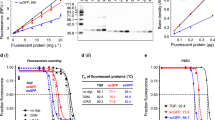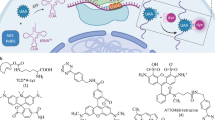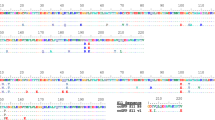Abstract
The green fluorescent protein (GFP) from the jellyfish Aequorea victoria has provided a myriad of applications for biological systems1. Over the last several years, mutagenesis studies have improved folding properties of GFP (refs 1,2). However, slow maturation is still a big obstacle to the use of GFP variants for visualization. These problems are exacerbated when GFP variants are expressed at 37°C and/or targeted to certain organelles. Thus, obtaining GFP variants that mature more efficiently is crucial for the development of expanded research applications. Among Aequorea GFP variants, yellow fluorescent proteins (YFPs) are relatively acid-sensitive, and uniquely quenched by chloride ion (Cl−)3. For YFP to be fully and stably fluorescent, mutations that decrease the sensitivity to both pH and Cl− are desired. Here we describe the development of an improved version of YFP named “Venus”. Venus contains a novel mutation, F46L, which at 37°C greatly accelerates oxidation of the chromophore, the rate-limiting step of maturation. As a result of other mutations, F64L/M153T/V163A/S175G, Venus folds well and is relatively tolerant of exposure to acidosis and Cl−. We succeeded in efficiently targeting a neuropeptide Y-Venus fusion protein to the dense-core granules of PC12 cells. Its secretion was readily monitored by measuring release of fluorescence into the medium. The use of Venus as an acceptor allowed early detection of reliable signals of fluorescence resonance energy transfer (FRET) for Ca2+ measurements in brain slices. With the improved speed and efficiency of maturation and the increased resistance to environment, Venus will enable fluorescent labelings that were not possible before.
This is a preview of subscription content, access via your institution
Access options
Subscribe to this journal
Receive 12 print issues and online access
$209.00 per year
only $17.42 per issue
Buy this article
- Purchase on Springer Link
- Instant access to full article PDF
Prices may be subject to local taxes which are calculated during checkout


Similar content being viewed by others
References
Tsien, R.Y. The green fluorescent protein. Ann. Rev. Biochem. 67, 509–544 (1998).
Crameri, A., Whitehorn, E.A., Tate, E. & Stemmer, W.P.C. Improved green fluorescent protein by molecular evolution using DNA shuffling. Nat. Biotechnol. 14, 315–319 (1996).
Jayaraman, S., Haggie, P., Wachter, R.M., Remington, S.J. & Verkman, A.S. Mechanism and cellular applications of a green fluorescent protein–based halide sensor. J. Biol. Chem. 275, 6047–6050 (2000).
Nagai, T, Sawano, A., Park, E.S. & Miyawaki, A. Circularly permuted green fluorescent proteins engineered to sense Ca2+. Proc. Natl. Acad. Sci. USA 98, 3197–3202 (2001).
Sawano, A. & Miyawaki, A. Directed evolution of green fluorescent protein by a new versatile PCR strategy for site-directed and semi-random mutagenesis. Nucleic Acids Res. 28, e78 (2000).
Reid, B.G. & Flynn, G.C. Chromophore formation in green fluorescent protein. Biochemistry 36, 6786–6791 (1997).
Miyawaki, A. & Tsien, R.Y. Monitoring protein conformations and interactions by fluorescence resonance energy transfer between mutants of green fluorescent protein. Methods Enzymol. 327, 472–500 (2000).
Heikal, A.A., Hess, S.T., Baird, G.S., Tsien, R.Y. & Webb, W.W. Molecular spectroscopy and dynamics of intrinsically fluorescent proteins: coral red (dsRed) and yellow (Citrine). Proc. Natl. Acad. Sci. USA 97, 11996–12001 (2000).
Griesbeck, O., Baird, G.S., Campbell, R.E., Zacharias, D.A. & Tsien, R.Y. Reducing the environmental sensitivity of yellow fluorescent protein. J. Biol. Chem. 276, 29188–29194 (2001).
Miyawaki, A., Griesbeck, O., Heim, R. & Tsien, R.Y. Dynamic and quantitative Ca2+ measurements using improved cameleons. Proc. Natl. Acad. Sci. USA 96, 2135–2140 (1999).
Lang, T. et al. Ca2+-triggered peptide secretion in single cells imaged with green fluorescent protein and evanescent-wave microscopy. Neuron 18, 857–863 (1997).
Tsuboi, T., Zhao, C., Terakawa, S. & Rutter, G.A. Simultaneous evanescent wave imaging of insulin vesicle membrane and cargo during a single exocytotic event. Curr. Biol. 10, 1307–1310 (2000).
Pouli, A., Kennedy, H., George Schofield, J. & Rutter, G. Insulin targeting to the regulated secretory pathway after fusion with green fluorescent protein and firefly luciferase. Biochem. J. 331, 669–675 (1998).
Angleson, J.K. & Betz, W.J. Monitoring secretion in real time: capacitance, amperometry and fluorescence compared. Trends Neurosci. 20, 281–187(1997).
Miyawaki, A. et al. Fluorescent indicators for Ca2+ based on green fluorescent proteins and calmodulin. Nature 388, 882–887 (1997).
Cadwell, R.C. & Joyce, G.F. Mutagenic PCR. PCR Methods Appl. 3, S136–S140 (1994).
Acknowledgements
The plasmid construct pEGFP-N1-NPY was provided by W. Almers. We are grateful to W. Almers and R.Y. Tsien for valuable comments, M. Yamamoto-Hino, Y. Kawano, K. Shimizu, T. Miyata, and K. Nakamura for technical advice, and H. Kuramochi for technical assistance. This work was partly supported by grants from CREST (the Japan Science and Technology Corporation) to A.M., the Japanese Ministry of Education, Science and Culture to A.M., Special Postdoctoral Researcher Program of RIKEN to T.N., and President's Special Research Grant of RIKEN to T.N.
Author information
Authors and Affiliations
Corresponding author
Rights and permissions
About this article
Cite this article
Nagai, T., Ibata, K., Park, E. et al. A variant of yellow fluorescent protein with fast and efficient maturation for cell-biological applications. Nat Biotechnol 20, 87–90 (2002). https://doi.org/10.1038/nbt0102-87
Received:
Accepted:
Issue Date:
DOI: https://doi.org/10.1038/nbt0102-87
This article is cited by
-
An optimum study on the laser scanning confocal microscopy techniques for BiFC assay using plant protoplast
Botanical Studies (2024)
-
StayGold variants for molecular fusion and membrane-targeting applications
Nature Methods (2024)
-
Optimized transgene expression in the red alga Porphyridium purpureum and efficient recombinant protein secretion into the culture medium
Plant Molecular Biology (2024)
-
Multidimensional characterization of inducible promoters and a highly light-sensitive LOV-transcription factor
Nature Communications (2023)
-
Development of two mouse strains conditionally expressing bright luciferases with distinct emission spectra as new tools for in vivo imaging
Lab Animal (2023)



